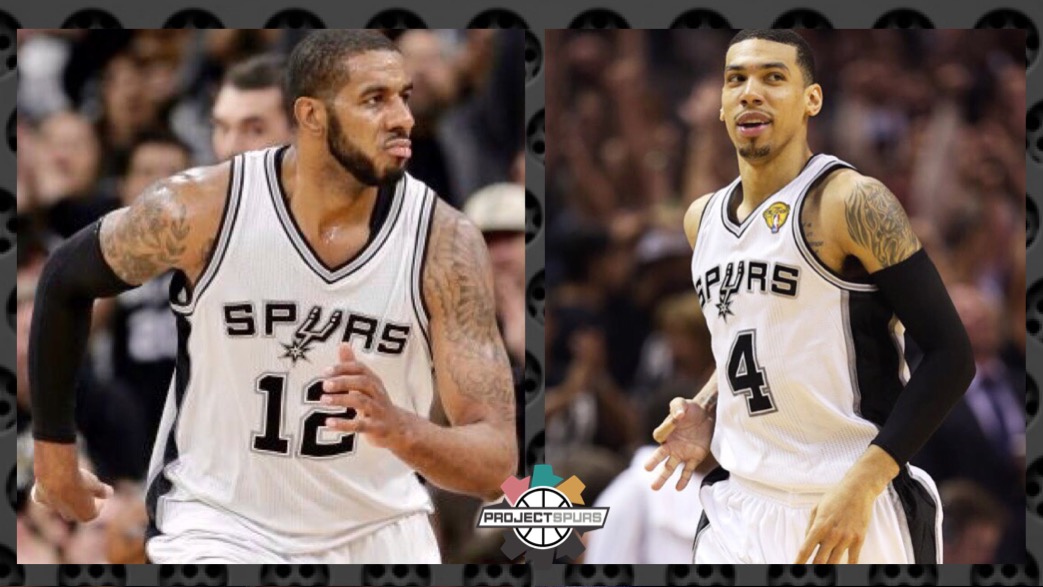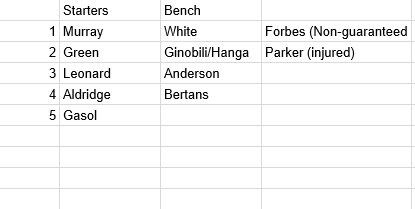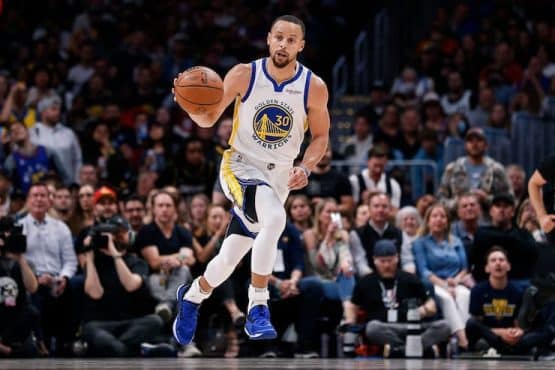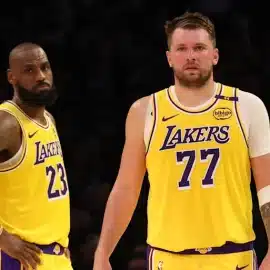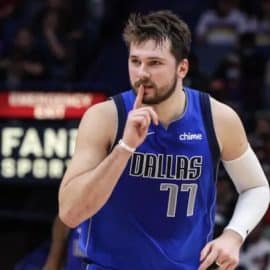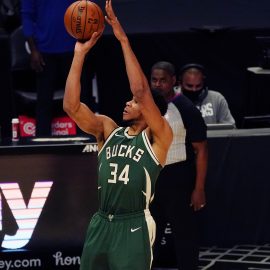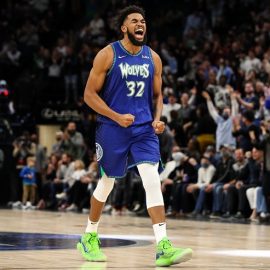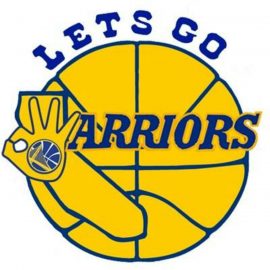What position do the Spurs need most heading into free agency?
This summer, most, if not all of the members of the San Antonio Spurs’ primary bench unit are hitting the free agent market. Dewayne Dedmon and David Lee have both declined the final year of their contracts, Manu Ginobili may retire, Jonathon Simmons is a restricted free agent, and Patty Mills is an unrestricted free agent. There is a distinct possibility that any or each of these players receive offers from teams that the Spurs can’t beat, meaning the Spurs will have to reconstruct some of their bench this offseason. In contrast, barring a cap space clearing trade, all of the players that make-up the Spurs’ primary starting lineup are under contract for next season, with the exception of Pau Gasol, who, after declining his player option for next season, is expected to re-sign with the Spurs on a longer deal.
So what pieces do the Spurs already have in place to fill their bench unit? Kyle Anderson and Simmons traded places in the rotation throughout last season and if Simmons does receive an offer that the Spurs are not willing to match in free agency, Anderson will likely become the full-time backup small forward, while still sliding to power forward in certain small ball lineups. Davis Bertans is a talented player who’s game will almost certainly show growth this upcoming season due to his increased familiarity with the Spurs and the NBA as a whole. He will probably become the second unit’s primary power-forward. If the Spurs are unable to re-sign Patty Mills and don’t sign one of the point guards they are reportedly interested in this free agency, new Spurs draftee Derrick White may get a good chunk of the backup point guard minutes, especially while Tony Parker is out and Dejounte Murray is likely starting.
Finally, David Pick reported that there is a good chance that Adam Hanga will join the Spurs this offseason if Ginobili does retire:
Sources tell me Euroleague DPOY Adam Hanga could land in San Antonio IF Manu Ginobili retires. Spurs 2011 stash.
— David Pick (@IAmDPick) May 23, 2017
That would bring the current Spurs’ depth chart to look something like the following:
The most obvious holes from their roster as currently projected are at backup center and the lack of NBA experience at the point guard position, at least until Parker returns from his injury.
What is the Spurs’ cap situation heading into free agency?
Project Spurs’ very own Paul Garcia has created an excellent series of videos on the Spurs’ cap situation in different scenarios. I am linking one below that discusses the Spurs’ cap situation in the event of trading Danny Green. While there is a good chance Green is not traded, it includes info for cap holds and gives a picture of the Spurs’ cap space before a trade for Green as well:
Here's the LATEST Spurs cap video if they moved Danny Green: https://t.co/KnV1RxnPbo https://t.co/SHnFr5QNcE
— Paul Garcia (@PaulGarciaNBA) June 21, 2017
In his projections, Paul calculates the Spurs’ cap space at 23 million dollars before a Green trade, but with roster charges, it’s only $20.2 million. This number may fluctuate a bit depending on what they sign Ginobili or Hanga for and if they guarantee Bryn Forbes contract, but without a major trade, that is roughly the Spurs’ current cap space.
Should the Spurs trade LaMarcus Aldridge?
There has recently been a lot of talk surrounding Aldridge and his Spurs future. Several reporters plugged into the league have reported that Aldridge would prefer the Spurs to trade him and doing so would be beneficial to the flexibility of the Spurs’ cap space. Whether or not trading Aldridge would be beneficial to the Spurs’ championship aspirations is a separate question entirely.
Trading Aldridge solely for cap space would leave a pretty large hole in the Spurs’ big man rotation. Much of the cap space trading Aldridge creates would have to go into signing a starter-quality big man. Blake Griffin is a free agent this off-season, but signing him would mean the Spurs would not be able to pursue any of the free agents they have been linked to so far as signing Griffin would tie up most of their available cap space, leaving the Spurs with roughly $10 million in cap space to re-sign Gasol.
Receiving a player in a trade for Aldridge would solve this to a degree, but that presents problems as well as the Spurs would have to take on a large contract if they were to trade Aldridge for a player of similar skill level or probably live with a lack of big man depth if they traded Aldridge for a player on a less expensive contract.
Trading Aldridge for cap space is not enough without the guarantee of signing a top tier free agent. Having cap space alone doesn’t guarantee signing a marquee free agent, and trading Aldridge for cap space while missing on signing any big name free agents would damage the Spurs’ roster more than most realize.
If the right deal comes along, the Spurs’ front office will make it. It’s hard to imagine, though, what the “right” deal would look like in this situation. The best move appears to be keeping Aldridge through the end of his contract, and if he does leave next season in free agency, use that cap space to sign a big name as the Spurs are currently projected to have much more cap space next off-season anyway (up to $64.4 million).
Should the Spurs trade Danny Green?
No, probably not. As Paul noted in the video I linked above, renouncing all of their free agents and trading Green while taking no salary back frees up about 32.2 million dollars in cap space, but with roster charges, that number goes down to $29.4 million which does not clear enough space for a max contract for players with 10+ years experience in the league. Even if it did, or if the Spurs used that space to sign a marquee free agent who doesn’t have 10 years of experience such as George Hill, this would create a huge hole in the Spurs’ wing rotation that the Spurs would be probably forced to fill with minimum contracts or exceptions. It would also break up what may be the league’s best defensive wing duo in Green and Kawhi Leonard.
Another point to consider is that Green is on a very team-friendly contract. While his shooting has been streaky at times, teams would be willing to pay an elite defensive wing who can stretch the floor much more than the $10 million the Spurs are currently paying him. Trading him for cap space alone is doing the other team a bigger favor than it does the Spurs, as it gives them Danny Green on a team friendly deal for this season and the Bird rights to re-sign him in the next offseason if he opts out (which he almost certainly will). If the Spurs traded Green, they would probably look to get more back than just cap-space, so trading him solely for the purpose of creating room for another free agent probably is not worth it.
Should the Spurs trade Tony Parker?
Trading Tony Parker would certainly give the Spurs more cap flexibility to work with this offseason, but there is a lower than slim-to-none chance it happens. The Spurs pride themselves on being a stable, character-focused organization and have used that image to lure the attention of free agents in the past. Trading a franchise player who has expressed interest to continue playing with the team as long as possible while that player is injured directly combats the image that the Spurs work so hard to maintain. While it may seem like a path to create some cap space for the Spurs, it would be surprising if it was even an option to the front office. Even further, unloading the contract of an aging, injured point guard in this market would require the Spurs to include another lucrative asset to the receiving team. The Spurs trading Parker is practically unfeasible at this point.
Should (and can) the Spurs sign a star this free agency?
It depends on who the star is and what the star is willing to take to come to San Antonio. Giving any star a max contract, even the smaller scale max for less experienced players, would restrict the Spurs’ flexibility throughout the rest of free agency. If the Spurs could somehow sign both George Hill and JJ Redick to deals that equaled a combined $29.4 million after a hypothetical Green trade, which is almost certainly not enough space to sign both players, they would be able to improve the offensive ceiling of their starting unit without sacrificing much wing depth, but that would leave only minimum salaries and exceptions to fill out the rest of the roster. In short, unless a star player is willing to take a discount, creating the necessary space for said star will almost certainly require the Spurs to make moves that would detract from their team more than adding that star would benefit them.
Who should the Spurs pursue in free agency?
As boring of an answer as this may seem on the surface, making competitive offers to attempt to re-sign Mills, Simmons, and Dedmon makes a lot of sense for the Spurs. Mills brings veteran leadership to the point guard position, which will be important throughout the season, but especially while Parker is out. Simmons is an athletic wing, a role that is becoming increasingly valuable in today’s NBA, and Dedmon is a solid big man who specializes in rim protection. It is very possible that teams will make offers to one or all three of these players that the Spurs are unable to match, but the Spurs can use the cap space created by Gasol opting out to at least be competitive in trying to re-sign these players.
Beyond that, if the Spurs don’t make any significant trades this offseason, backup center is the first position of need that really sticks out on the Spurs’ current roster. Nene seems like a potentially solid option, as he is coming off of a strong season with the Houston Rockets. Aron Baynes opted out of the final year of his contract, creating the possibility of a reunion with the Spurs. Past that, the center market isn’t incredibly robust this offseason, especially considering that it seems like the Dallas Mavericks are committed to matching any offer Nerlens Noel receives.
Past centers, Andre Iguodala would probably be a good fit on this Spurs’ roster, mainly because Iguodala would be a good fit on almost any team. Vince Carter may be on the wrong side of 40, but seems willing and able to play for a couple more seasons and would provide some veteran leadership to what may be a surprisingly young Spurs’ bench. If Mills does leave in free agency, the Spurs could test the market for Shaun Livingston as he would also provide a veteran presence to what looks to be a young point guard rotation. Many of the other intriguing free agents this summer are restricted free agents whose incumbent teams seem motivated to re-sign, limiting the total number of available players on the market.
What is the long term direction of the current Spurs’ roster, and how will the Spurs move in that direction this offseason?
In both of the two most recent drafts, the Spurs have drafted 6’5″ point guards in the first round in Dejounte Murray and Derrick White. In the second round of the most recent draft, the Spurs drafted Jaron Blossomgame, an athletic wing, who, in a pre-draft interview with the Philadelphia 76ers’ Brian Seltzer (found below), revealed that he prides himself on being able to defend multiple positions.
.@JaronBgame (@ClemsonMBB) goes 1-on-1 with @brianseltzer after working out for the team » https://t.co/HG7FQbYKg9 https://t.co/QBYUsH8DGb
— Philadelphia 76ers (@sixers) June 13, 2017
The league is continuing to move towards position-less basketball and heavily switch-dependent defensive schemes. While there are certainly exceptions on the Spurs’ current roster, many of the moves the Spurs have made in recent off-seasons, especially for younger players, have followed this style as well. This off-season has already been a success to that end with the Spurs drafting White and Blossomgame and would be an even further success in the pursuit of this modern NBA philosophy if the Spurs are able to re-sign Simmons. While there is a lot of time before a decision has to be made with free agency, summer league, and training camp still to come, I honestly believe there is a good chance that the Spurs sign Blossomgame to a guaranteed contract as soon as next season.
Finally, the best way the Spurs can benefit their future this off-season is by not tying up too much money in long term contracts. The Spurs only have two guaranteed contracts on the book for the 2018-2019 season, Leonard’s contract and the final year of retired Tim Duncan’s stretched contract. That will certainly change this off-season for many reasons, but by refraining from tying up too much of that future cap space, the Spurs are in a great position to keep many pieces of a 61-win roster while having the space to make a splash in next year’s free agency.
Salary information from http://www.basketballinsiders.com/san-antonio-spurs-teamsalary/ unless stated otherwise.
Add The Sports Daily to your Google News Feed!
